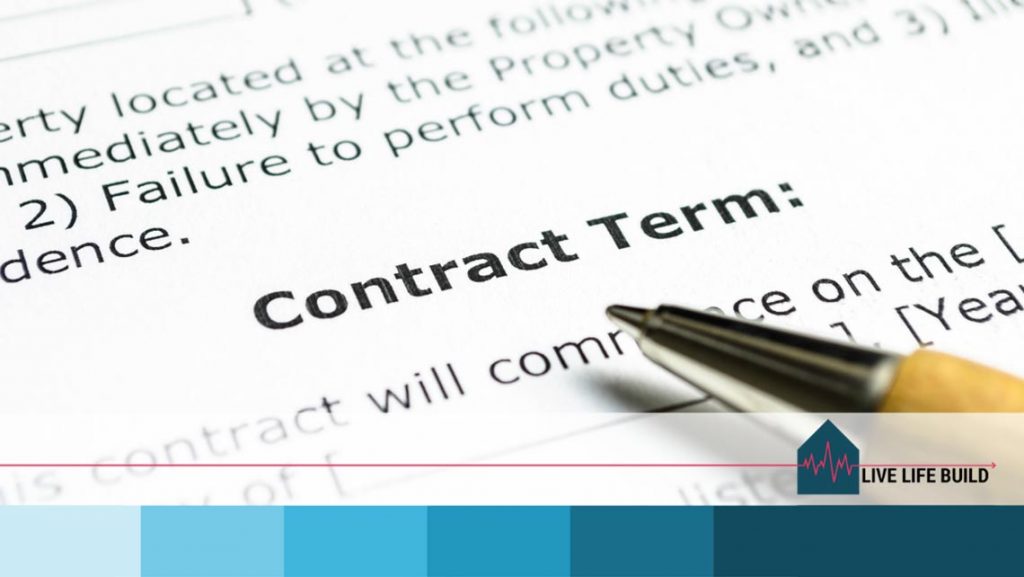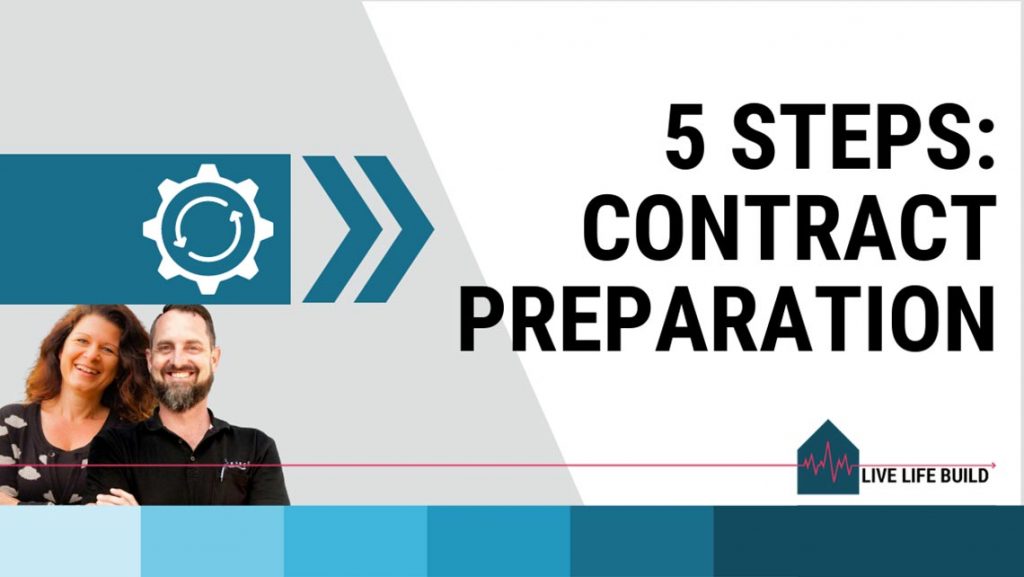How do you manage your building contract preparation so you do it accurately and don’t make mistakes?
Learn the 5 steps of building contract preparation here. Read on.
Believe it or not, a building contract has everything you need to execute your projects well.
And yet, so many builders have never taken the time to read their contracts thoroughly. So, they don’t understand them, don’t follow the required contractual processes, and struggle with their clients (who also don’t understand the contract or follow the required contract processes).
Your contract is not simply something you sign and put back in the drawer.
It’s an opportunity to highlight your authority and your professionalism, and to help your clients feel more confident in you, as well as manage their expectations about their project. And you can start using it now to make your projects far more successful.
Want to know how? Here’s 5 steps to your contract preparation to get you started.
5. DECIDING ON WHAT CONTRACT TO USE
Have you ever put much thought into the contracts you are using with your clients?
A lot of the time, when you start a building business, you start out with just a handshake or maybe a single piece of paper with some notes on it that you sign. This works for a while, while you are doing smaller jobs for family and friends.
Then as you start to get busier, you might start using contracts that you may have seen your boss using, or that a client has recommended. Or you can even get into situations where an architect is telling you the contract that you must use.
There are so many contracts available for builders to use, it’s hard to know where to start. There are contracts for:
- renovations
- new builds
- different values and
- types of work.
Then on top of this, the contracts are very different depending on where you get them from.
You can get contracts from government bodies, industry associations, some design professionals have their own, and you can even use ones designed for your business by a lawyer. There are literally dozens of different contracts that all have different standards and clauses. And depending on the one you use can all have very different interpretations.
Because of this, it’s really important that you review every project that you are involved in and decide what contract CAN be used, and what contract best suits the project and your business.
When deciding what contract to use, remember that the contract is your ‘rules of the game’, or the tool of execution. It outlines everything you must do and everything the client must do.
When executed correctly, the contract will make every project a success. The contract is your best friend when you run your business by it.

4. UNDERSTAND YOUR CONTRACTS (OR GET LEGAL ADVICE)
So many builders get themselves into trouble repeatedly because they blame everything and everybody else around them, especially when it comes to their projects.
Duayne used to be one of these builders.
For years, he would:
- Blame the clients for not paying his bills on time or in full.
- Blame the clients for showing up on site all the time and talking to his trades and employees.
- Blaming his contractors for doing extra work without him knowing
- Blame the clients for not paying for variations.
- Blame his staff for doing things prior to having approval from clients
- Blame the clients for always putting extra pressure on him and his team about moving in early or with out paying the final payment
These are just a few examples (as Duayne could talk all day about all the scenarios and situations that he was constantly having).
Every scenario was simply a result of him not using the contract to run his business.
Duayne says this about this time in his business, and about his contracts:
“Contracts scared me as I didn’t believe in myself enough to put in the effort to understand them. A big part of this was that I didn’t think I was smart enough to read them. And even if I did, I wouldn’t be able to execute things the way they needed to be. When I look back now, I can’t believe how much money I lost and how much trouble I kept getting into by having this mindset.”
At the end of the day, you can’t run a building business without using contracts, so you must get an understanding of them to be able to have a successful business.
Because of Duayne’s experience, and what we see happening for so many builders, the advice we now give in Live Life Build is this:
Don’t overthink things when it comes to contracts. Read them. Use them as your rule book. Because that’s exactly what they are. Think of building as a game and your contracts are the rules of the game. When you follow the rules and execute them well you will always win every time, and there’ll be no more trouble with clients or bills not getting paid.
As boring as it may be, schedule some time in and sit down with the contracts you use. Read them front to back including all the clauses and definitions in the back. You will find as you read through them that they aren’t actually that hard to understand, and the more times you read them you will start to see how you can use them as the rules for your business.
The clauses and definitions in the back generally outline everything that you the builder and the client must do, and the time frames it must be done in. It’s also very important that if you have admin staff that deal with a lot of the contract side of things that they read and understand the contracts as well.
While you are reading through the contract, have a highlighter and mark any clauses that you don’t understand or need further clarification of so you can get professional advice on these ones.
Remember if you are using an industry body contract, they will be happy to take your call and explain things to you. This could end up being the best phone call you ever make and save you lots of heartache.
The contract is your rule book so use it like one. Understand it, and get help and legal advice if you don’t.

3. DISCUSS YOUR CONTRACT WITH YOUR CLIENTS PRIOR TO SIGNING
Once you have a good understanding of the contracts you are using in your business, you can start using it to your advantage, so your potential clients see you as a professional.
Most builders have no idea of the clauses in the contracts they use and have never taken the time to even read through the contract and know how to execute it.
We hear so many stories of builders getting into huge trouble because they don’t follow the requirements of the contract – and yet their clients do (because they have read them!)
Isn’t it amazing that so many builders have never read their contracts and executed them correctly, then complain when clients hold them to the contract? This happens all the time.
Knowing your contracts well is such a powerful tool when meeting with potential clients, as it shows you know what you are doing. But most importantly it sets you up as the authority and manages their expectations about how the process will go.
For a lot of clients, it’s very comforting to know that they are talking to a builder that runs their projects and business as per the contract. This shows them that you have systems and processes for dealing with all the things that they have heard horror stories about.
So, when discussing your contract with your client, be sure to mention things like:
- Dealing with a variation, what happens?
- How do costs get adjusted if there is an allowance?
- What will happen at handover?
- Are they allowed to visit the site?
- Who do they communicate with on a day to day basis?
- What happens if there’s a delay?
- What time frames do all correspondence have to be responded to by?
- How do progress draws work?
- What happens if the project goes over time?
- How do they make selections and sign off on things?
- What happens if there’s a latent condition?
On top of being able to give them a demonstration of how you will run their project, it also helps them understand the terminology that gets used during a build. When a client doesn’t understand what you’ve asked of them or told them, it can be a big contributor to conflicts during a build as clients. So you can reduce or eliminate this by taking the time to explain these terms used in the contract.
A huge part of why the PAC Process is so successful is that it gives you the time and opportunity to be constantly referring to the contract during the design stage.
Understanding your contracts well enough so that you can be discussing certain clauses during the early stages is also very powerful when it comes to the clients making a final decision. When you do it well before the time of signing the building contract, your clients will have full trust in you and the project will be a great success.

2. OTHER DOCUMENTS TO GO WITH YOUR CONTRACT
Don’t get put off because we’ve mentioned more documents! We know the contracts can be a lot to deal with so why would you make it any harder, hey?! The fact is that the more effort you put in prior to signing the contract, the more successful the project will be.
So many builders are caught in the cycle of just racing to make ends meet, which means they are always racing to get the next contract signed and often don’t complete it correctly.
The first time they realise they have messed up is when the clients bring something up that’s been missed, or they can’t get a payment because some of the paperwork is incomplete.
There can be other documents required to actually complete the contract, so it’s good to have a checklist of everything you need completed before you start on site.
Some of these other documents can be:
- Building specification
- Photographic release form (if you are taking photos or video this is a must).
- Commencement agreement.
- Engineers’ specification form
- Proof of funds to pay the full contract amount.
- Proof of building insurance, especially if the project is a renovation.
- Consent to electronic communication
These are just some examples as it will depend on the contract you are using.
One way to streamline this for yourself is to create a checklist of all the documents you need as part of signing the contract. A checklist will help you remember it all, plus be able to show your client what needs to be prepared, and enable you to outsource what you can to admin staff as well.
Putting the time and the effort into creating a checklist for completing your building contracts is so important. Making sure you have all the correct information and that it’s all signed off will seriously save you if things turn bad.

1. PRESENTING YOUR CONTRACT TO YOUR CLIENT
For most people, contracts are scary things that they don’t understand and so, they quite often make people very anxious.
When you know this, you can help your clients deal with it and develop systems and processes to help your clients feel comfortable. Duayne’s experience and work in this area has meant that, by the time it comes to signing the contract with his clients, it’s a short and straightforward meeting with a handshake and a hug to finalise it!
It wasn’t always this way, and in the past Duayne would occasionally have clients leaving a contract signing meeting having not signed the contract because they had concerns.
Clients would want to seek legal advice and often want to change or add new clauses to the standard contracts they were using. And often, this was only because Duayne hadn’t explained to them how he dealt with all the situations that come up during a build. However, the main reason was that the clients hadn’t had enough time to review the contract.
A powerful part of our PAC Process is not only discussing the contract during the design stages but also sending the clients a draft copy very early on so they can review it.
By doing this and giving your clients the chance to read through it over a couple of months (ahead of when you need them to sign it) gives them the chance to ask questions and have discussions with you. It’s also good to give examples of contractual situations while you are attending design meetings.
Encourage your clients to get legal advice sooner rather than later (if they feel the need) so it gives you time to work through things with them. You don’t want the client coming to you with a huge range of concerns just before you are expecting to sign. If there are things that you feel the client may need some extra advice on after discussions they have had with you, encourage them to get some legal advice.
The key to you being seen as the authority is understanding the contracts you use and being able to explain things to you clients at every stage. This also builds trust and makes your clients feel confident in you so when it comes time to sign the contract it’s a smooth process.
This helps them see that the contract is not only your rule book as their builder – it’s their rule book too. And when they feel confident you understand it, and know how to execute your projects according to it, they’ll feel more confident in your ability to professionally run their project. It’s the best way to start, and run, any renovation or build.

So, here’s our 5, 4, 3, 2, 1 to identify your ideal project.
5. Have you asked your team what their goals are?
4. How can you help and facilitate your team’s goals?
3. What are your goals as a team?
2. Holding people accountable.
1. Celebrate the wins and create a good work environment.
Live Life Build’s 6P Methodology unlocks the 6 ways to elevate your building business:
PERSONAL | PROJECTS | PEOPLE | PARTNERSHIPS | PROCESSES | PROFESSIONAL
Want to learn how to be a better business owner? Learn the systems, marketing tools, mindset and business skills you need in our group program and mastermind, ELEVATE. Learn more here.

